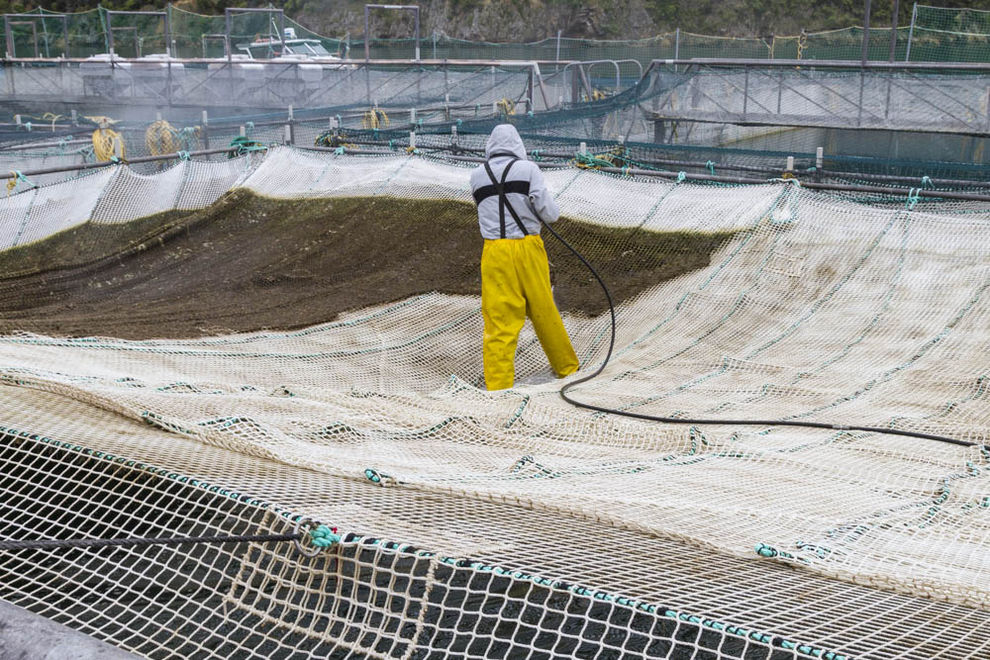King Salmon and Indigenous Fish
Changes to the seabed and pelagic effects

Deposition of faeces and uneaten feed causes changes to the seabed beneath finfish farms. These particles are organic-rich and can alter the physical, chemical and biological nature of the seabed, increasing microbial activity. This in turn can decrease oxygen levels in the sediment and lead to changes to the biodiversity of the area.
These effects tend to be greater in finfish farming than in shellfish farming. However, they can be minimised by siting farms in deep, well flushing locations and by good farm management such as using higher quality feed to gain an improvement in feed conversion rates (meaning that less feed is needed to grow a fish), and using automated feeders with shut-off signals linked to underwater cameras that detect waste feed. 1709 Farmed areas can also be rotated so that areas of the seabed are regularly fallowed to allow recovery. Such approaches are also important for reducing the effects that uneaten food and fish waste have on the water column.Short term fallowing can be an important tool to break potential disease cycles.
Changes to local biodiversity
Finfish farms can cause changes to local biodiversity, in particular a decrease in those benthic species that are intolerant of the enriched conditions and a corresponding increase in species that are adapted to them. Wild fish and other species can be attracted to finfish farms because they feed on the dropped fish feed and use the structures for shelter.
Toxic chemicals
Currently, in New Zealand, feed for farmed salmon does not contain antibiotics, vaccines, steroids or colourants. Astaxanthin is naturally present in wild king salmon diets. It is included in fishfeed to mimic the diet of wild fish and is necessary for maintaining fish health. Astaxanthin is available across the counter as a human health supplement.
Therapeutants (vaccines, anti-fouling paints and feed) are all potential sources of chemical pollutants to the marine environment. Farmed finfish are very susceptible to diseases and large numbers of chemical treatments can be needed to combat these diseases. Finfish feed contains zinc as one of the necessary dietary components. Zinc can accumulate in sediments beneath salmon farms at levels potentially toxic to benthic organisms. The zinc now used in salmon feed is organic and has much reduced impacts on the benthic environment. Any effects are thought to be limited to the footprint of the farm. 1710
Therapeutants for treating parasites and diseases have not been required in New Zealand salmon farms, due to the relatively low density and small scale at which they are farmed, and absence of diseases. However, the expansion of finfish farming into new areas and other types of fish may require new methods of disease prevention. Kingfish trials undertaken in the Marlborough Sounds indicate that there may be a need for disease treatments because kingfish are unusually susceptible to some parasites. One method of treatment may be by low concentration in-water baths of hydrogen peroxide.
Finfish farmers, have in the past used antifouling paint to prevent the build-up of biofouling organisms on nets. These paints gradually wash off and can accumulate on the seabed under the farms. Historically, many of these paints contained copper, which in high concentrations is toxic. The extent to which such concentrations of copper may impact on marine life is not fully understood, although it may be toxic to organisms living in the sediment. 1711 The effects are normally confined to the boundary of the farm.
Although manual removal is possible for farm nets, recent developments in in-water net cleaning technologies has meant antifouling paints on nets is no longer the only option. Where the use of antifouling paints cannot be avoided, new copper-free anti-fouling paints are now available, and there has been a significant reduction in the use of copper in antifoul paints by the aquaculture industry.
-
Forrest et al., 2007 para 3.3.2
-
Kelly S, 2008, 7
-
Forrest B et al., 2007, 35
Last updated at 3:08PM on February 2, 2018